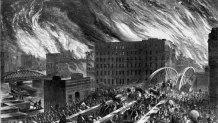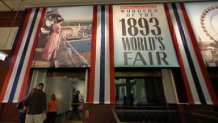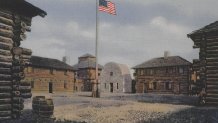Most American cities have their own flags, but few are as famous or as well-known as the city of Chicago’s, which has flown proudly over the city for more than a century.
Chicago’s original flag was designed in a City Council-sponsored contest in 1917. The winning design was submitted by Wallace Rice, an author and a lecturer at the Art Institute of Chicago.
The original flag had the beginnings of its iconic design with two blue bars and two six-pointed red stars.
A third star was added in 1933, and the fourth star was added in 1939.
Feeling out of the loop? We'll catch you up on the Chicago news you need to know. Sign up for the weekly Chicago Catch-Up newsletter here.
Each part of the flag holds symbolic meaning, according to city Municipal Code 1-8-030 and a fact sheet produced by the Chicago Library detailing the evolution and meaning of the banner.
Here is a breakdown of every symbolic meaning of Chicago’s flag.
Three White Sections
Local
While the eye’s attention is inevitably drawn to the blue stripes and the red stars on the flag, the three distinct white areas also have meaning, according to the Chicago Library.
The three white sections are designed to symbolize the North, West, and South sides of Chicago.
The Blue Stripes
The sky-blue stripes on the flag give the banner its first pop of color, and have been used in a wide variety of settings to help symbolize the city, including on sports uniforms.
The top stripe was designed to symbolize both Lake Michigan, which borders the city on its eastern side, and the North Branch of the Chicago River. The North Branch of the river is formed by the convergence of three bodies of water, and enters Chicago near the intersection of Milwaukee Avenue and Devon Avenue.
The bottom stripe was designed to symbolize the South Branch of the river, which is formed by the North Branch and the main stem of the river, which originates from Lake Michigan since the flow of water was reversed away from the lake.
It also represents the “Great Canal,” a 28-mile-long canal system that connects the river to the Des Plaines River. The canal is also the only water-based connection between the Great Lakes and the Mississippi River system.

The Stars
Each of the four stars on the Chicago flag represents a different historical event, codified in the city’s municipal code, and each of the six points on those stars also have unofficial symbolic meaning, according to the Chicago Library.
Rice deliberately included six points on each of the stars because a five-pointed star is intended to represent sovereign states, as they do on the flag of the United States.
First Star – Great Chicago Fire
An original star on the flag that was unveiled in 1917, the star represents the Great Chicago Fire, which took place in 1871. The fire killed an estimated 300 people and destroyed roughly three-square miles of the city and more than 17,000 buildings.
Other countries and the U.S. government stepped in to help rebuild the city, including a donation from the United Kingdom helped to fund the Chicago Library system in the aftermath of the fire.
The six points on this star represent the city’s transportation, labor, commerce, finance, populousness and its health in the aftermath of the tragic fire.

Second Star – World’s Columbian Exposition of 1893
Also on the original flag, the second star represents the World’s Fair, which took place in Chicago in 1893 and showcased the remarkable turnaround after the fire had destroyed much of the city just two decades earlier.
The remarkable fair, which covered nearly 700 acres and took place in areas around Jackson Park, was hailed as a massive success, and gave the city some of its most iconic structures, including the Museum of Science and Industry.
The six points on this star represent some of the focuses of that fair, including religion, education, aesthetics, justice, benevolence and civic spirit.

Third Star – Century of Progress Exposition
Also known as a “World’s Fair,” the Century of Progress Exposition took place between 1933 and 1934, with the third star added to the Chicago flag during that time.
The event celebrated Chicago’s centennial, and the theme was technological innovation. It took place along Lake Michigan and Northerly Island.
The points of this star represents a variety of feats and features of the city, including its status as America’s second-largest city at the time of the fair, as well as the city’s motto Urbs in horto, which translates as “City in a garden” in Latin.
“I Will” is an alternative city motto, and is also represented by a point on this star. The other three points on the star represent different attractions at the Fair, including the Great Central Marketplace, Wonder City and Convention City.

Fourth Star – The Founding of Fort Dearborn
The final star on Chicago’s flag was added in 1939, and represents the founding of Fort Dearborn.
The fort was constructed beside the Chicago River, and was named after Secretary of War Henry Dearborn. The original fort was destroyed during the War of 1812, but was reconstructed on the same site before being decommissioned in 1837.
The widening of the Chicago River took away part of the fort’s remnants, and the rest of it was destroyed by the Great Chicago Fire in 1871.
Today, visitors can find planks from the fort at the Chicago History Museum, and plaques outline a portion of the fort near the intersection of Wacker Drive and Michigan Avenue.
The six points of this star represent the different countries and U.S. government entities that have had control over Chicago throughout history, including France and England. Illinois was originally part of Virginia until 1778 when it was designated as part of the “Northwest Territory.”
According to the Chicago Library, Chicago was part of the Indiana Territory until 1802, and was then designated as part of Illinois, which became a U.S. state in 1818.
Fifth Star Proposals
A number of proposals have been floated over the years to add a fifth star to the flag, whether to honor the late Mayor Harold Washington, the Great Chicago Flood of 1992, or the dominance of the Chicago Bulls.
The latest proposal was made by Mayor Lori Lightfoot to commemorate the city’s response to the COVID-19 pandemic.



